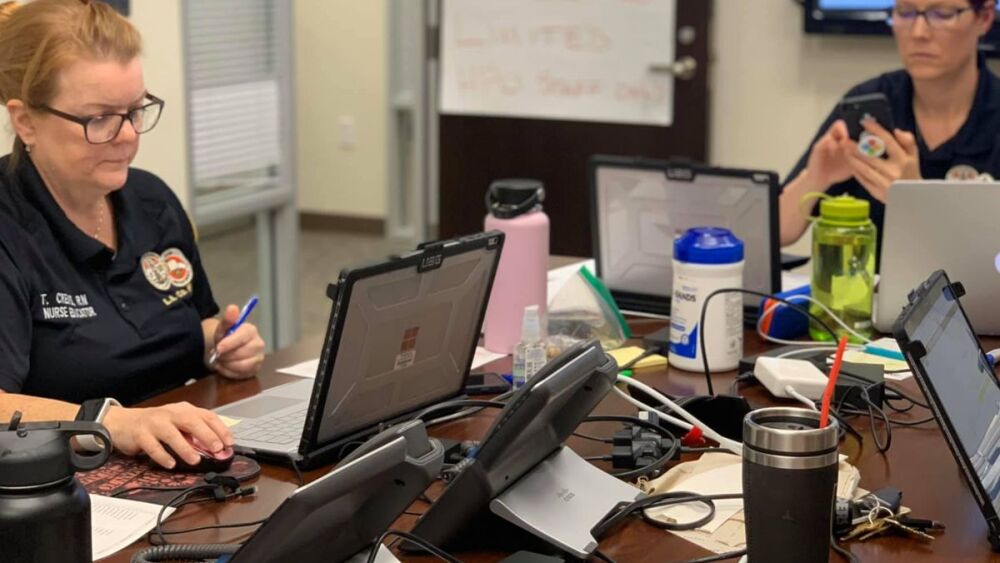As the COVID-19 pandemic continues, one of the nation’s largest agencies, L.A. County Fire Department (LACoFD), realized it quickly needed a robust system in place to clinically track and monitor its approximately 3,600 firefighter/paramedics and firefighter/EMTs across its 174 stations, covering 2,300 square miles.
With over a third of a million EMS calls for service annually, LACoFD was already dealing with high call volume. The addition of COVID-19 related calls and the risks to staff presented a major tracking challenge. In the opening weeks of the COVID-19 pandemic, LACoFD saw a significant increase in the number of exposed and symptomatic personnel, and realized that they needed a better way to track the health and exposure of their responders.
The rapid tracking solution they adopted was modeled on a system first used in Cypress Creek EMS (CCEMS) in Spring, Texas, north of Houston. The CCEMS team repurposed its charting platform, already deployed to track and monitor its community paramedicine staff. After contacting Beyond Lucid Technologies, the California-based software company behind MediView Trips, the system was reconfigured to look at CCEMS staff. The solution turned the CP/MIH model inward, inverting the traditional concept of CP/MIH (which has typically focused on chronic care patients) by implementing a 14-day community paramedicine-like tracking program for its at-risk crews.
CCEMS set up two provider-patient cohorts in the MediView Trips software (Suspected and Confirmed) to track vitals and other clinical data about its team members who were suspected of COVID-19 exposure. MediView Trips is a module that follows CP/MIH patients in a longitudinal fashion, like a clinic or hospital EHRs. The module integrates with NEMSIS-type PCRs to create a continuous view of a patient throughout their care. The system can integrate with HL7 EHR systems to allow a full view of the continuum of care.
Answering an immediate need in the COVID-19 pandemic
Realizing the immediate need for such a large employed population at risk, LACoFD also signed on to use the MediView Trips platform on Mar. 23, adding more granular cohorts that provide for up to 21 days of tracking, including Self-Monitoring, Self-Isolation, Sent Home Sick, Return to Work, and several tiers of clinical triage based upon potential exposure risk (Low, Low Enhanced, Medium and High).
This increased LACoFD’s Health Programs Office staff’s ability to manage the consequences of COVID responses and provide a continuous, strategic view of the health of the workforce in the face of COVID-19.
Terrence McGregor, LACoFD senior EMS program head and clinical director said, “In addition to the system used by Cypress Creek, BLT also automated our exposure reporting and monitoring forms, which enabled us to create longitudinal charting of our personnel. We now can track each of our personnel from the onset of exposure or illness, through their return to work.”
Going forward, LACoFD is now importing data in real-time from forms completed twice daily by monitored personnel which, once submitted, become a part of each responder’s chart.
Additionally, submissions and follow-up notes from clinical staff are also added to the chart to document the full course of each responder’s progress. LACoFD’s clinical staff are also making daily contact with each isolated or symptomatic responder to complete a more thorough evaluation of their condition, which is documented within their chart.
Once the data is reviewed, responders are placed into the appropriate monitoring/isolation program based upon risk and/or symptoms. Personnel are categorized for their monitoring and follow-up based on four categories: Low, Medium, High (isolation) and Sick.
Profiles are pre-populated from data imported from personnel (roster) and ePCR systems, such that when an initial report of exposure is submitted, full demographics are populated into the patient record. All data that would be captured in a standard PCR can be included, including PMH, medications and insurance/workers’ comp information. Capability also exists to submit the health record to hospitals if necessary, to refer personnel for treatment as well as capture and report COVID testing status for personnel who meet our testing criteria.
BLT makes no formal charge for the use of the MediView system to track staff exposed to COVID-19, but considering the global emergency, offers it on a “whatever you can afford” basis. McGregor added that, “given the significant threat we face on the front lines of this health crisis, the rapid deployment, ease-of-use, and comprehensiveness of MediView Trips has given the Los Angeles County Fire Department the tools needed to protect and care for our personnel.”
Read next: King County (Wash.) shares EMS return-to-work resources for COVID-19














